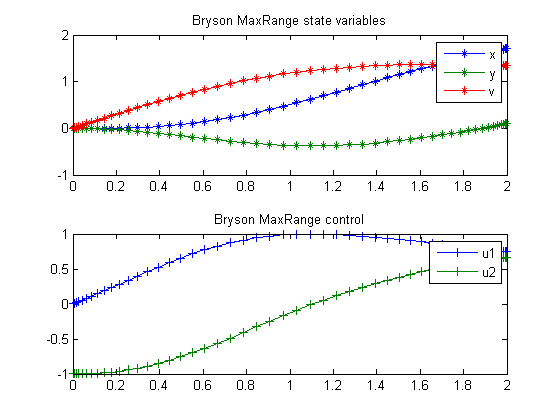Bryson Maxrange
Contents
Problem description
Max range version of Bryson-Denham problem
% Copyright (c) 2007-2008 by Tomlab Optimization Inc.
Problem setup
toms t p = tomPhase('p', t, 0, 2, 50); setPhase(p); tomStates x y v tomControls u1 u2 % Various constants and expressions xmin = -10; xmax = 10; ymin = xmin; ymax = xmax; Vmin = -100; Vmax = 100; g = 1; a = 0.5*g; % Initial guess x0 = collocate({u1 == 1; u2 == 0}); % Box constraints cbox = {xmin <= icollocate(x) <= xmax ymin <= icollocate(y) <= ymax Vmin <= icollocate(v) <= Vmax -100 <= collocate(u1) <= 100 -100 <= collocate(u2) <= 100}; % Boundary constraints cbnd = {initial({x == 0; y == 0; v == 0}) final(y == 0.1)}; % ODEs and path constraints ceq = {collocate({ dot(x) == v.*u1 dot(y) == v.*u2 dot(v) == a-g*u2 }) collocate(u1.^2+u2.^2 == 1)}; % Objective objective = -final(x);
Solve the problem
options = struct;
options.name = 'Bryson MaxRange';
solution = ezsolve(objective, {cbox, cbnd, ceq}, x0, options);
t = subs(collocate(t),solution);
x = subs(collocate(x),solution);
y = subs(collocate(y),solution);
v = subs(collocate(v),solution);
u1 = subs(collocate(u1),solution);
u2 = subs(collocate(u2),solution);
Problem type appears to be: lpcon
===== * * * =================================================================== * * *
TOMLAB - Tomlab Optimization Inc. Development license 999001. Valid to 2010-02-05
=====================================================================================
Problem: --- 1: Bryson MaxRange f_k -1.712314875015308500
sum(|constr|) 0.000000100745336446
f(x_k) + sum(|constr|) -1.712314774269972000
f(x_0) 0.000000000000000000
Solver: snopt. EXIT=0. INFORM=1.
SNOPT 7.2-5 NLP code
Optimality conditions satisfied
FuncEv 1 ConstrEv 55 ConJacEv 55 Iter 34 MinorIter 169
CPU time: 0.500000 sec. Elapsed time: 0.516000 sec.
Plot result
subplot(2,1,1) plot(t,x,'*-',t,y,'*-',t,v,'*-'); legend('x','y','v'); title('Bryson MaxRange state variables'); subplot(2,1,2) plot(t,u1,'+-',t,u2,'+-'); legend('u1','u2'); title('Bryson MaxRange control');
